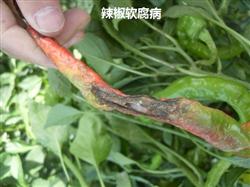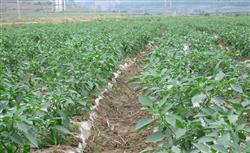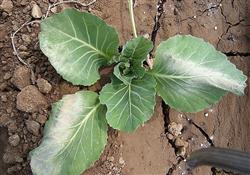Pepper planting techniques: what are the diseases of chili?

What are the diseases of chili? Please introduce and guide how to control the common diseases and insect pests of growing chili, such as soft rot, blight, carbon gangrene, bacterial wilt and virus. Detailed introduction and control methods can refer to the following: pepper soft rot: when soft rot occurs, the fruit spot is water-stained at the initial stage, and then it decays and falls off, with a bad smell. The decayed fruit only has a layer of skin, which is whitened by the sun. The disease often occurs in the high temperature and rainy season. Pepper soft rot control methods: first, avoid continuous cropping, including eggplant, tomato and other Solanaceae crops. Second, 50PPM agricultural streptomycin or neophytomycin whole plant spraying and root irrigation. Pepper blight can occur in both seedling stage and adult stage, but it is very easy to occur in early spring. During the occurrence of the blight, the stem disease of the seedlings showed water stains, the leaves withered, and then soft rot occurred, folding to death, while the adult plants showed brown disease spots on the stems and leaves, causing fallen leaves and even withered, and the fruit showed waterlogged disease spots, and then soft rot. Pepper blight prevention and control methods: first, seedling watering is not too much, the field is not too wet, especially in rainy days pay attention to drainage. Second, before planting, the whole ground was sprayed with 1000 times of chlorothalonil, and then covered with plastic film to seal sterilization. Third, after planting, you can spray mancozeb wettable powder 600 times liquid to protect, once every 15 days, spray 40% phosphate aluminum wettable powder 200 times liquid or 75% chlorothalonil wettable powder 600 times liquid, or 64% poison alum M8 wettable powder 400-500 times liquid, 40 kg per mu, once every 7-10 days, 2-3 times in a row. Pepper anthracnose: leaf infection, initially a faded green water-soaked spot, gradually turning brown, light gray in the middle, whorled small black spots on the spot. Fruit stalk sometimes damaged, brown sunken and irregular, dry and cracked when dry. When the fruit was killed, there were water-immersed yellow-brown or irregular spots, with raised concentric patterns and many black spots, and the surface of the spot overflowed red sticky matter when it was wet. The disease spots on the fruit are easy to dry and shrink like a membrane, and some of them are ruptured. Pepper anthracnose control methods: first, select disease-resistant varieties, disease-free plants remain seeds. Second, seed treatment: pre-soak in cold water for 1-2 hours, then soak in 55 degrees warm water for 10 minutes, and then cool in cold water to accelerate germination and sow seeds. You can also soak the seeds in cold water for 10-12 hours, then soak the seeds with 1% copper sulfate for 5 minutes, or soak them with 50% carbendazim wettable powder 500 times for 1 hour, and neutralize the acid with plant ash or a small amount of lime before sowing. Third, strengthen field management. Reasonable close planting, formula fertilization, timely ventilation in the greenhouse, avoiding high temperature and humidity, paying attention to drainage, timely removal of diseased leaves, diseased fruits and residues, and rotation with non-identical vegetables for 2-3 years. At the initial stage of the disease, spray 70% methyl thiophanate wettable powder 600-800 times liquid, or 80% mancozeb wettable powder 500 times liquid, or 75% chlorothalonil wettable powder 800 times liquid mixed spray, or 50% carbendazim wettable powder 300-400 times liquid or 1purl 200 times Bordeaux solution, once every 7-10 days, a total of 2-3 times. Pepper bacterial wilt: when the plant is sick, individual branches may wither at first, and then spread to the whole plant, especially the sunny weather after rain. Pepper bacterial wilt control methods: first, the use of protective fungicides such as ammonia copper, second, pull out the diseased plants in the field, and sprinkle lime in the nest. Pepper virus disease: there are two main types, mosaic necrosis, caused by tobacco mosaic virus. Diseased leaves show irregular chlorosis, dark green and light green mosaic, brown necrotic spots appear on some leaves, dark brown necrotic stripes appear along the stem from the main vein of the leaves, resulting in falling leaves, flowers, fruits, and death of the whole plant. The leaves are strangely clustered, and the plant is deformed by cucumber mosaic virus infection, which is characterized by thickening, shrinking or fern-like leaves, chlorosis, wrinkling, uneven and linear internodes. The plant is dwarfed, the branches and leaves are clustered, and the diseased fruit shows flower spots or necrotic spots, odd shape and easy to fall off. In cultivation, if silver-black plastic film mulching is used and insecticides are used to kill aphids, the incidence rate is low, and in general extensive cultivation, it is necessary to do a good job in killing aphids. Pepper virus disease control methods: first, pay attention to kill aphids, second, plant disease 1000 times liquid, spray once before planting, once every 7-10 days after planting, 2-3 times in a row. Third, the symptoms of virus disease should be sprayed with virus A400-600 times in time, once every 7-10 days. Fourth, spray 800 times of "chlorophyll essence" fertilizer once every 7-10 days to enhance the resistance of the plant, which can be used together with plant disease spirit and virus A. Click to get more chili planting techniques click to get more vegetable planting techniques
- Prev

Pepper planting technology: how to fertilize pepper after flowering?
How to fertilize chili after blooming? Please give guidance to pepper growth period is longer, need a large amount of fertilizer, generally in the seedling stage can be a small amount of fertilizer, can be combined with foliar topdressing, select appropriate calcium, magnesium, iron, manganese, boron and other trace element fertilizer; in the flowering and fruit setting period, the demand for nitrogen is larger, it can be appropriate at this time.
- Next

Cabbage planting: how to grow kale in autumn?
How to grow kale in autumn? Please introduce the method of cultivating cabbage in autumn. the growth period is short and the growth rate is fast. it is generally planted in mid-late September and can be harvested 60 days after planting. It can be cultivated in flat beds and delayed in autumn with mulch in the later stage, which can be extended to the market after New Year's Day. Detailed management methods can be referred to the following.
Related
- Where is it suitable to grow horseradish in China? it is expected to see the middle altitude horseradish in Alishan.
- How to prevent tomato virus disease reasonably? (Control methods included)
- Many people like to plant towel gourd on the balcony. What are the main points of this method and management?
- What crops can chili peppers be mixed with?
- Fertilization techniques and matters needing attention in Tomato
- What are the grafting techniques for peach seedlings in spring?
- Harm and control methods of root swelling disease of Chinese cabbage
- What are the pests of sweet potatoes? How to prevent and cure it?
- Symptoms, causes and Control methods of navel Rot in Tomato
- The cause of "Cucumber rotten bibcock" in Farmers' planting Cucumber and its Control Plan

